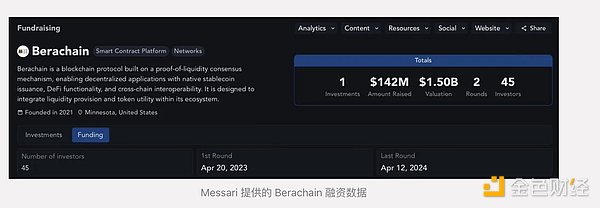
Author: Stacy Muur Source: substack Translation: Shan Oppa, Golden Finance
Maximum in the past 24 hours The news is that the Berachain main network will be launched on February 6th. Does this mean we have finally ushered in a new public chain that can shake the dominance of Ethereum and Solana?
Why is Berachain's launch known as one of the most anticipated events in on-chain history? Will it completely change the liquidity pattern? Can their innovative PoL (Liquidity Consensus Mechanism) really bring disruptive changes in economic models?
Let me share my views.
Berachain's data•Total financing: US$142 million (two rounds of financing), estimated Valued at $1.5 billion.
•Liquidity before the mainnet goes online: US$3.3 billion (data from Boyco + official Dune data), a total of 166,000 independent wallets provide liquidity.
• Testnet data (start from Bartio B2 to the end of 2024):
•3180 Ten thousand independent addresses
•513 million transactions
•2.5M addresses have been deployed 201.2 million contracts
Even if only considering the liquidity before the main network goes online, Berachain's TVL (total locked position) when entering the market has exceeded ZKsync. Starknet, Linea and Blast.
$BERA's core innovation: liquidity consensus mechanism (PoL)In-depth discussion of Berachain Before we can get the potential, we need to understand its Proof firstThe mechanism of Liquidity (PoL) will be the key to Berachain's comparison with modern L1.
Most blockchains (such as Ethereum, Solana) use PoS (Proof of Stake), which means that verifiers ensure network security by pledging native tokens.
However, Berachain pioneered the PoL (Liquidity Consensus) model, which directly integrates liquidity into cybersecurity mechanisms. Under the PoL mechanism, participants pledge assets into liquidity pools. These pledged assets not only guarantee network security, but also can be used for decentralized transactions and lending. This dual function not only improves security, but also ensures that liquidity within the ecosystem is fully utilized, forming a more efficient and dynamic financial environment.
In other words, in Berachain's PoL system, liquidity providers, validators and ordinary users can actively participate in the network through economic incentives.
This model is in sharp contrast to Ethereum's PoS, where most of the transaction fees of Ethereum are destroyed or distributed in a way that cannot directly benefit active participants.
Token Economics: Key pillarsBerachain's Token Economics revolves around three cores Token construction:
BGT (Berachain governance token)
for staking and protection Chain's non-transferable governance tokens.
Rewards are obtained through emissions when the user provides liquidity to the selected pool.
Determines how to allocate new token offerings to different liquidity pools, similar to Curve's veTokenomics.
BERA (Berachain Gas token)
is used to pay transaction fees within the network.
By irreversibly burning equal amountsThe BGT is created to ensure a deflation mechanism linked to the network usage.
HONEY (Berachain Stablecoin)
Pedge to USDC and used as Bend loan for Berachain The main lending assets in the agreement.
Mind currency through exchanges with USDC, incurring fees charged by the blockchain.
How do they be used in PoL?The user delegates the BGT to the verifier, and the verifier decides which liquidity pools receive emission rewards.
This creates a bribery market where DeFi projects incentivize BGT holders to direct emissions to their pools.
Liquidity providers (LPs) in the pool receive a share of BGT emissions and actively participate in governance.
Over time, governance rights are assigned to LP, thus strengthening the core function of the chain: DeFi.
BEX (Berachain Exchange): a decentralized exchange (DEX), Use BGT to reward liquidity providers to align incentives with PoL.
Berps (Berachain Perpetuals): A perpetual contract trading platform using HONEY as the main collateral and liquidity tokens.
Bend (Berachain Lending): A lending agreement in which users can borrow and lend assets, with HONEY as the main lending asset.
So how efficient is Berachain's model?Pros:
High TVL Attraction: This model is designed to attract high total lock value (TVL) as soon as possible , because LP is motivated to provide liquidity through BGT emissions.
Capital Efficiency: Unlike PoS chains where pledged tokens are idle, Berachain ensures that assets that provide secure maintain liquidity and availability in the ecosystem.
EVM compatibility with Cosmos interoperability: Berachain's Polaris EVM ensures Ethereum compatibility while benefiting from Cosmos' cross-chain capabilities.
Deflation BERA Model: The irreversible BGT to BERA destruction mechanism provides a sustainable supply control method.
Disadvantages:
Governance centralization risk: As BGT cannot be purchased and must be obtained through emissions, governance rights may be concentrated in early large LPs.
Barriers to new agreements: Berachain may lose the motivation to launch new agreements because it includes core DeFi protocols (DEX, perps, lending).
Lack of active capital Flow: This model attracts passive LP capital, but may be difficult to generate substantial income outside of emissions, reflecting Curve's inefficiency.
Last thoughtBerachain’s Token Economics is a well-thought-out system that directly links liquidity supply to cybersecurity. While its PoL model effectively attracts liquidity, its long-term sustainability depends on governance distribution, protocol diversity Improvements in sexuality and scalability.
Berachain can challenge if it successfully expands and cultivates a vibrant ecosystem outside its established protocol Leading Layer-1 and Layer-2 solutions.











